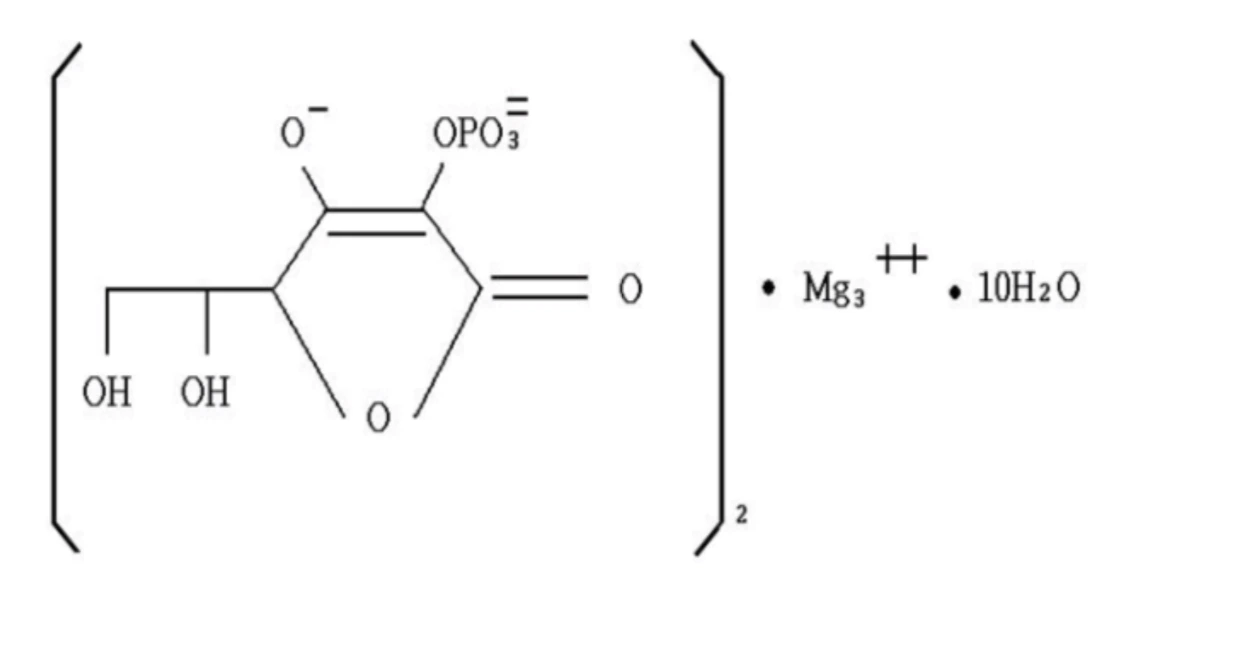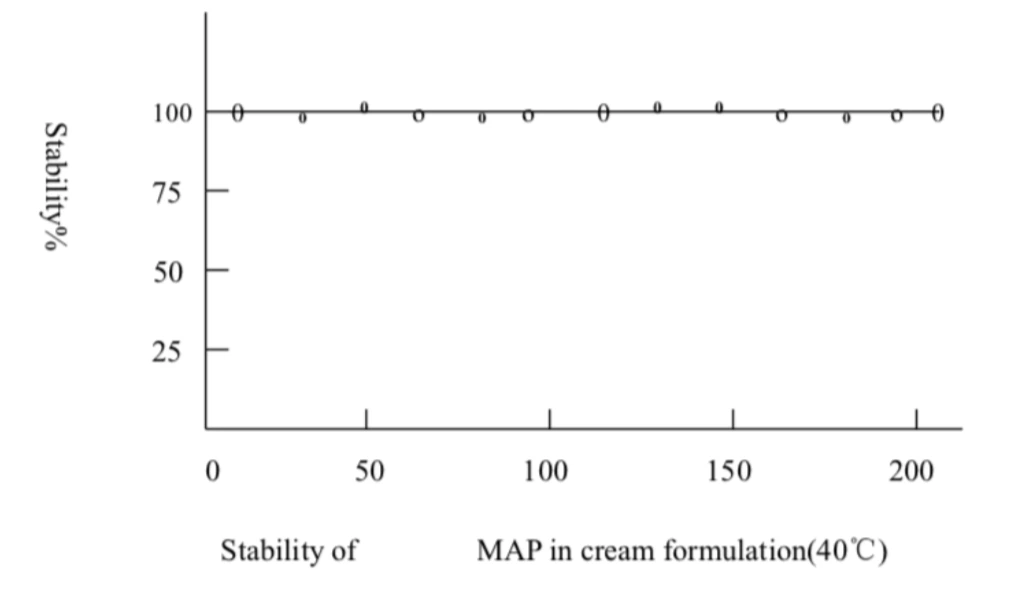Magnesium L-Ascorbic acid-2-Phosphate
Magnesium L-Ascorbic acid-2-Phosphate
Additional information
| Product Name | Magnesium L-Ascorbic Acid-2-Phosphate (MAP) |
|---|---|
| Appearance | White to pale yellow powder |
| Cas No. | 113170-55-1 |
| Solubility | High soluble in water |
| Specification | Cosmetic grade &Food grade, Assay NLT 95% |
| Main Applications | Cosmetics, Skincare, Haircare, Dietary Supplement, etc. |
Product Details

What is Magnesium L-Ascorbic Acid-2-Phosphate?
Magnesium L-Ascorbic Acid-2-Phosphate, also known as Magnesium Ascorbyl Phosphate (MAP), is a stable, water-soluble derivative of Vitamin C (ascorbic acid). It combines the antioxidant properties of Vitamin C with the stability of magnesium, making it an ideal ingredient for skincare and cosmetic applications.
In functional cosmetics, vitamin C exists in three main forms:
- L-Ascorbic Acid (Active Vitamin C): The purest form of vitamin C, commonly found in creams, serums, and masks. L-Ascorbic acid is effective in the metabolism process of a lot of living creatures such as collagen synthesis, anti-oxygen, ferrous absorption of the bowel, and metabolism of amino acids. Ascorbic acid has several documented physiological and pharmacological effects on the skin. It can inhibit melanin formation and promote collagen formation.
- Unfortunately, ascorbic acid can not be applied to any cosmetic products because of its poor stability in water, even at 25℃, which means that it is highly unstable and prone to oxidation when exposed to air or light, causing product discoloration.
- Magnesium Ascorbyl Phosphate (MAP): A stable, water-soluble derivative of vitamin C that is less prone to oxidation, making it ideal for cosmetic formulations. It is easily formulated and very stable in water. It shows the activity of long anti-oxygen.
- Ascorbyl Palmitate: A fat-soluble form of vitamin C that is more stable than L-ascorbic acid but less stable than MAP. It is often used in combination with other forms to enhance skin absorption and product longevity.
These three forms provide different benefits and stability profiles, with magnesium ascorbyl phosphate (MAP) being the most stable in cosmetic products, including both solution and emulsion formulations.

CAS Number and Chemical Structure
- CAS No.: 113170-55-1
- Chemical Formula: C12H12MgO18P2
- Molecular Weight: 456.49 g/mol
The compound consists of a Vitamin C molecule esterified with a phosphate group, stabilized by a magnesium ion, which enhances its stability and makes it more suitable for formulation in various products.

Specification of Magnesium L-Ascorbic Acid-2-Phosphate (MAP)
| Product Name | Magnesium L-Ascorbic acid-2-Phosphate (MAP Powder) |
| Appearance | White to pale yellow powder |
| Assay | ≥95.00% |
| Loss on drying | ≤20.0% |
| Heavy metal (as Pb) | ≤0.001% |
| Arsenic | ≤0.0002% |
| PH(3% aqueous. solution.) | 7.0~9.0 |
| Free ascorbic acid | ≤0.5% |
| Free Phosphoric acid | ≤1% |
| Chloride | ≤0.35% |
Properties:
Magnesium L-Ascorbic Acid-2-Phosphate (MAP) is a water-soluble VC ramification. It is very stable in water. Therefore, it is effective in skin care products.
MAP can inhibit melanogenesis formation, promote collagen synthesis, and prevent lipid peroxidation. The combination of MAP and Vitamin E or other anti-oxygen agents can catch the free radical of oxygen, reduce erythema because of ultraviolet radiation, prevent dry skin, sunburn, chloasma, and ephelides, and keep the skin healthy and young.
MAP can prevent coloring matter subsiding by inhibiting the enzyme activity of tyrosine and is very effective in whitening the skin.

Solubility:
Magnesium L-Ascorbic Acid-2-Phosphate (MAP) is insoluble in almost all solvents except water.. The transparency of MAP (3%) aqueous solution was examined in the presence of various concentration of ethanol,polyols and saccharides, respectively. As a result, a transparent solution was obtained when each material was added at the following percentage.
Ethanol: 5% max
Propyleneglycol, 1,3-Butyleneglycol, Maltiol: 10% max
Glycerin, PCA-Na: 15% max
Formulation Stability:

The stability of MAP was evaluated in a cream formulation. The cream was prepared according to the following formulation and was left for about 200 days at 40℃. As the following figure shows, it was confirmed that even after this period has passed, more than 90% of MAP was retained in the cream. In order to keep the stability of MAP , the PH of the formulation should be over 7.0 and a buffer silution and/or a chelating agent should be added, if required.

Benefits and Functions
- Potent Antioxidant: Protects the skin against oxidative damage caused by UV radiation and environmental stressors.
- Anti-aging studies have shown that when the skin is exposed to ultraviolet light, it produces reactive clusters (ROS) including peroxide ions, hydrogen peroxide, and atomic oxygen. These ROS are produced by causing direct chemical changes in DNA, cell membranes, and proteins, including collagen. Harmful effect. L-ascorbate Vitamin C is the most abundant antioxidant in human skin. This water-soluble vitamin has the effect of de-electronizing, neutralizing free radicals and protecting intracellular structures from oxidative stress.
- The role of light protection: MAP does not absorb ultraviolet light in the solar spectrum and does not act as an opacifier itself. However, it has a photoprotective function when used alone, and is more desirable when used in combination with vitamin E. Studies have shown that 15% L-vitamin C magnesium phosphate combined with 1% vitamin E has a better photoprotective effect. However, it is important to note that it must be used before UV exposure and reused 30 minutes after UV exposure.
- Collagen Synthesis: Promotes collagen production, enhancing skin elasticity and reducing signs of aging.
- Brightening Agent: Inhibits melanin production, helping to fade hyperpigmentation, dark spots, and even out skin tone.
- Anti-inflammatory Properties: Helps soothe irritated skin and reduce redness.
- MAP has an anti-inflammatory effect and has been used to treat various inflammatory skin diseases. Topical MAP on mouse skin has also been shown to be up to 30 times more potent than ascorbic acid as a tumor suppressor.
- Studies have also shown that MAP is effective in the treatment of acne, silver sputum and fat-free eczema. It has been reported that topical MAP can improve inflammatory rose acne, but no objective clinical research data have been found.
- Anti-wrinkle, improve photoaging skin: MAP is generally used in cosmetics and is stable at pH neutral. It is a free radical scavenger and collagen-producing stimulator that can be converted to ascorbic acid across the epidermis. In in vitro studies using human fibroblasts, MAP and ascorbic acid have the same ability to stimulate collagen synthesis.
- A double-blind controlled trial of a 5% MAP cream applied to the neck and forearm of a moderately aging patient for 6 months was observed in the laboratory. It was observed that the deep wrinkles were significantly reduced, and the facial color and relaxation were also significantly improved.
- Whitening effect: MAP has the effect of helping to dilute pigmentation. Studies have shown that MAP can inhibit melanin formation by tyrosinase and melanoma cells, and topical MAP cream can significantly dilute chloasma and freckles.
Main Applications

- Skincare & Cosmetics: MAP is widely used in serums, lotions, creams, whitening products
and sunscreens for its skin-brightening and anti-aging properties. - Hair Care: It helps improve scalp health and provides antioxidant protection for hair.
- Dietary Supplements: Although mainly used in cosmetics, MAP can also be included in supplement formulations to deliver Vitamin C benefits.
How Does Magnesium L-Ascorbic Acid-2-Phosphate Work?
MAP is converted into active Vitamin C in the skin upon absorption, providing its potent antioxidant and collagen-stimulating effects. Its stable, water-soluble nature allows for more effective penetration into the skin without the risk of oxidation, unlike pure Vitamin C.
Dosage Guidelines
- Topical Skincare: Typically used at concentrations ranging from 0.5% to 3%.
-
Put MAP into light-free, seal container .
Use non-ion emulsification when make emulsion.
Keep PH value 7.0
Dissolve MAP in water, add it into emulsion at 40~50℃
Use chelating agent, such as Na3-EDTA, Na4-EDTA, Sodium Citrate. MAP will be decomposed in the presence of metal ions.
Its commend usage is 0.5% as anti-oxygen agent and 3% as whiten agent.
-
- Dietary Supplements: Consult with a healthcare professional for accurate dosage recommendations.
Why Choose Chibio Biotech for MAP?
- High-Quality Products: Chibio Biotech offers MAP with a purity of ≥ 98%, ensuring maximum effectiveness.
- Reliable Supply Chain: Consistent and reliable supply of high-grade MAP for all your formulation needs.
- Customized Solutions: Tailored specifications to meet your specific application requirements.
Why Use Magnesium L-Ascorbic Acid-2-Phosphate in Your Business?
- Superior Stability: Unlike traditional Vitamin C, MAP is stable and less prone to oxidation, extending the shelf life of your products.
- Versatile Applications: Suitable for various formulations, including water-based serums, creams, and lotions.
- Proven Efficacy: Delivers potent antioxidant, anti-aging, and skin-brightening benefits, making it a valuable addition to your product line.
Integrating Magnesium L-Ascorbic Acid-2-Phosphate (MAP) into your products can significantly enhance their performance and appeal to health-conscious consumers looking for effective, science-backed skincare solutions.
Get in touch with us to boost your business

- Get Free Sample
- Get Step Quote
- 24/7 Service
- Customized Specification
- Confidentiality Agreement
Headquarter
Block B, Vanke Center, No.2 Heilongjiang South Road, Shibei District, Qingdao City, China 266033
Phone
+86 (0)532 66983270
Cellphone / WhatsApp / WeChat
+86 156 6577 2296
+86 133 8100 5417




